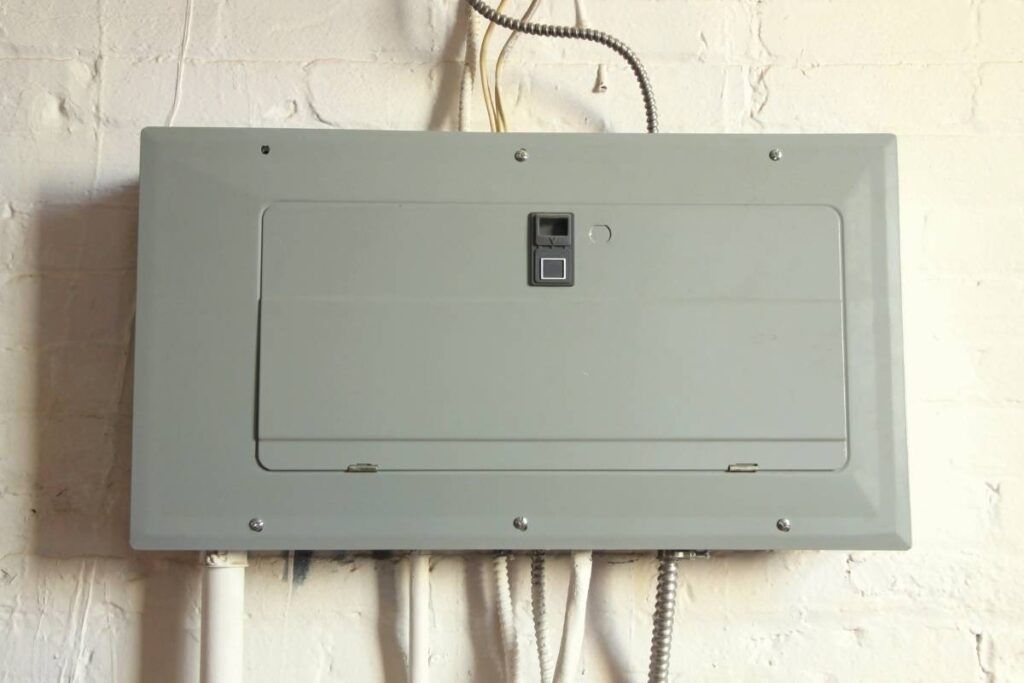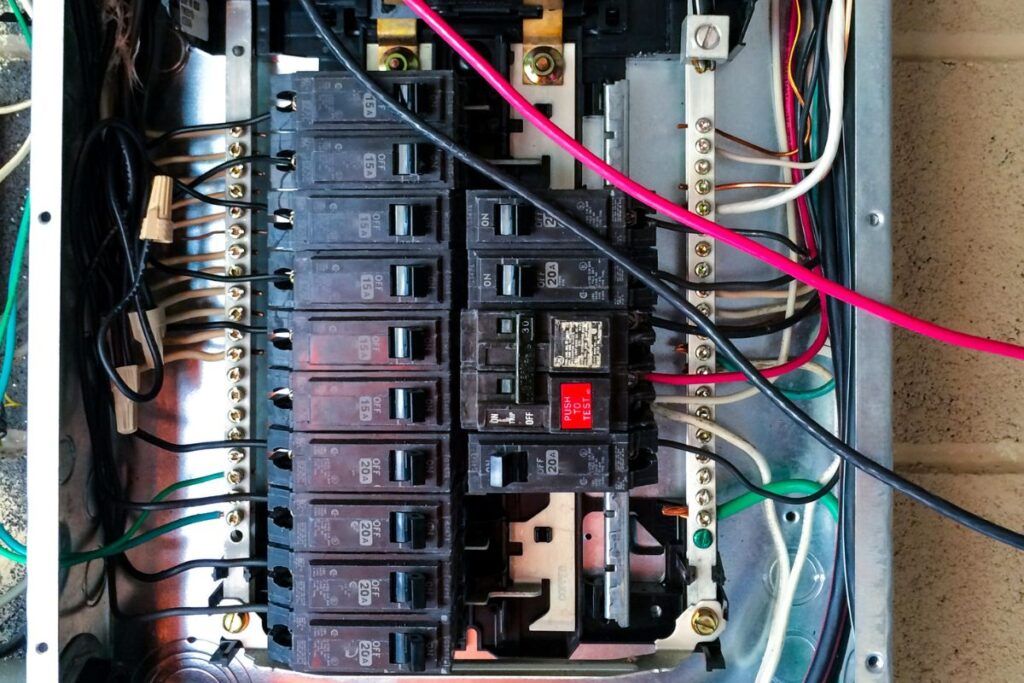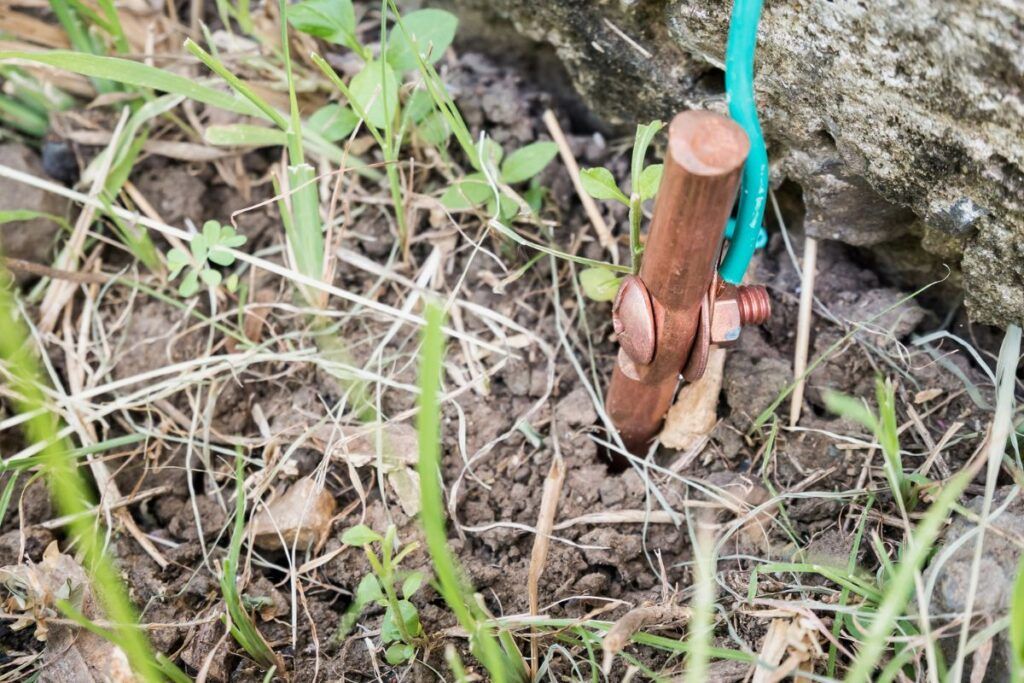Grounding a sub-panel is as essential as grounding the main panel. A subpanel is needed when the main panel has filled up, but you need a few more circuits. But how do you ground a subpanel for a detached building? Here’s what I found.
You must install a grounding electrode system for the subpanel in a detached building. Install it on the earth and run wires to the sub-panel. Different grounding methods include using a water pipe, rod, plate, ring, conductor, or encased concrete.
A subpanel will need a grounding only for a detached building. The central panel’s grounding will be enough in the same building. This article will provide detailed information about grounding a sub-panel, different ways to ground, and safety considerations.

Check out our list of top-handpicked products for all your electrical, appliance, and HVAC system needs to keep your home running smoothly.
This post includes some affiliate links.Understanding the importance of grounding a subpanel in a detached building
When your main panel is filled up, but you need to add more circuits to add a few more devices to your house, you can install a subpanel.
If you have installed a sub panel in the same building, you don’t need to ground it because it will already be connected to the ground wire.
Some people have a detached building, like a workshop or garage, where they want to add devices.
Here, you can use a subpanel instead of adding a panel.
Since the sub-panel will work as the main panel to power the detached building, you must ground it.
Grounding a subpanel for a detached building is essential in multiple ways:
- Grounding the sub-panel will protect against electrical shocks and short circuits, especially during the lightning. The excess current will get diverted to the ground instead of the building.
- Grounding will protect the electrical devices of your house that can damage due to sudden electrical surges and lightning strikes.
- Grounding the subpanel is vital for code compliance. According to the National Electric Code Article 250.32 (B) (1), a feeder or a breaker powering a detached building or structure must have a grounding conductor. So, failing to follow the codes results in penalty fines and failed insurance coverage.
Tools and equipment needed to ground a subpanel in a detached building
To ground a subpanel in a detached building, you need the following equipment:
- A grounding electrode to ground the subpanel
- A grounding conductor to run from the electrode to the sub-panel for grounding
- Wire cutters to strip the wire ends and connect them to the bus bars and the electrode
- Grounding clamps to attach the wires to the electrode.
- Screwdriver or wrench to attach the grounding conductor to the electrode
5 ways to ground a subpanel in the detached buildings
Grounding a sub-panel is similar to grounding the main panel.
For a perfect grounding, you need to know a few basics, like keeping the neutral and ground separate in the subpanels.
There are several ways to ground a subpanel in a detached building.
Whatever method you choose, make sure it is allowed in the local codes of your region.
Consult with an electrician before the installation if needed.
First, you must plan the electrical wiring while grounding a sub-panel in the detached building.
Another important thing you need to remember is to separate the ground and neutral in the sub-panel.
If your subpanel has no separate ground bus bar to connect the grounding wire, install one inside the panel.
Generally, the ground bus bar will be on the side or back of the sub-panel.
Here are 5 ways to ground a subpanel in a detached building:
1. Using a ground rod

A grounding rod system is a common and easy way to ground the subpanel for a detached building.
The rod must be copper or galvanized steel measuring 8 feet long and ½ inch wide.
The wire size should be appropriate for the subpanel rating.
The distance between the detached building and the grounding electrode should be 2 feet.
To ground a subpanel using a ground rod:
- Find an appropriate place to install the rod. Avoid areas with rocks and pipes.
- Choose a high-quality and durable ground rod for proper functioning.
- Dig around 2.4 meters of a hole in the ground and insert the rod into it.
- Install the subpanel and connect the hot and neutral wires to their bus bars.
- Clamp the rod’s upper part to one end of the grounding conductor and the other with the subpanel’s ground bus bar to connect the ground wire.
- Test the ground rod’s resistance with a multimeter or a clamp-on tester to ensure its functionality.
Ground rod has always been my first preference.
I have a detached garage where I have installed a 100 amp sub-panel and grounded it with a ground rod.
2. Concrete-encased electrode system
The Ufer grounding system is also known as the concrete-encased electrode system.
Install a grounding electrode conductor in a concrete foundation or the detached building’s footing.
The electrode will then be connected to the subpanel’s ground bus bar.
Here are the steps:
- Many people pre-plan it during the initial construction of the detached building. If you don’t have it, install one with a concrete foundation.
- Use a 4 AWG bare copper wire or ½ inch rebar in the middle of the foundation before the concrete settles down. The wire should be at least 20 feet long and ½ inch in diameter. It will be installed directly in the footing for direct contact with the ground.
- Connect a copper grounding conductor matching the subpanel’s amp rating to the electrode with a grounding clamp, and run it from the electrode to the sub-panel.
- Install the sub-panel in your building and connect the hot and neutral wires to their respective bus bars.
- Connect the grounding conductor to a separate ground bus bar in the subpanel. Make sure the ground and neutral remain separate.
- Use a jumper wire to bond the subpanel’s grounding and enclosure to ensure both have the same current potential.
- Test the grounding resistance with a digital multimeter or a clamp-on tester.
Follow the electrical codes before you use this method.
A ½ inch diameter rebar is enough for a 100 to 200 amps subpanel.
I have seen one such system in one of my friend’s homes.
3. Grounding ring system
In a grounding ring system, you install a conductive ring around the building’s perimeter and connect it to the grounding system.
Then, connect the conductor to the ring and the ground bus bar in the subpanel.
Here are the steps to install the grounding ring:
- First, select a proper location around the building’s perimeter to bury the grounding ring.
- Select a grounding ring and install it close to the detached building. The ring should be 2 feet wide and 8 feet long, like the grounding rod.
- Dig a trench around your detached building and install the ring into the ground.
- Like in other systems, connect the grounding conductor to the electrode and run it from the electrode to the sub-panel.
- Install the subpanel and run the hot and neutral wires to their respective bus bars.
- Connect the grounding wire separately to the ground bus bar. If the neutral and ground bus bars are bonded, separate them by installing a separate ground bus bar in the subpanel.
- Bond the ground bus bar with the subpanel’s enclosure with the jumper wire.
- Test the grounding system.
4. Grounding plate
If you use a grounding plate, install it outside the detached building in the ground.
Here are the steps:
- Choose the correct grounding plate. It should be made of copper or galvanized still and measure around 2 feet wide and 8 feet long.
- Find a suitable location to bury it to ensure it remains in contact with the ground.
- Connect the grounding conductor to the plate and run it from the electrode to the detached building’s subpanel.
- Install the subpanel, connect the hot and neutral to the respective bus bars, and the grounding conductor to a separate grounding bus bar.
- Use a jumper wire to bond the grounding bus bar and the subpanel enclosure.
- Test the grounding resistance. If the reading is lower than 25 ohms, everything is fine.
Before approaching, consult with the contractors to ensure a grounding plate is allowed in your region.
5. Metal water pipe
Another method is using a 10 feet long copper or galvanized water pipe.
It would be best to have a metal water pipe to run to your detached building. After that, the steps are the same as the above methods.
Below are the steps for water pipe installation:
- Find the water pipes entering your detached building. The pipe needs to be made of copper or galvanized steel. Otherwise, you cannot use it to ground the detached building’s subpanel. Additionally, it needs to be at least 0 feet tall.
- Clean the water pipe, especially near where you will attach the grounding clamp. Use a sandpaper or wire brush to clean the dirt and corrosion.
- Attach the clamp to the clear part of the pipe and tighten it for enough electrical contact. The clamp must be UL-listed for burial.
- Connect the grounding conductor to the clamp with a screwdriver and run it from the electrode to the sub-panel.
- Install the subpanel and connect the hot and neutral wires to their bus bars. Connect the ground wire to a separate ground bus bar in the subpanel. Don’t bond the neutral and grounding connection.
- Use a jumper wire to bond the subpanel’s ground bus bar and the enclosure to ensure equal electrical potential.
- Test the grounding resistance.
You must ensure that this process applies to your region in the local codes.
Contact a local professional for assistance if you hesitate to install the grounding.
How to connect ground wires to the subpanel in a detached building?

A ground wire runs to the ground bus bar in the subpanel to connect the grounding electrode to the sub-panel.
To run the ground wires in the subpanel:
- Find the correct wire gauge that matches the amp rating of the sub-panel.
- Install the electrode outside the detached building by driving it into the ground.
- Run a grounding conductor’s one end to the electrode and the other end to the sub-panel.
- Install the subpanel and connect the hot and neutral wires to their respective bus bars. Then, connect the ground conductor to the separate grounding bus bar in the subpanel.
- Bond the ground bus bar with the subpanel’s enclosure to ensure both have the same electrical capacity.
- Test the grounding system with a ground resistance tester.
Tips for testing the effectiveness of the grounding system for the subpanel
After you have grounded the subpanel, you must check its effectiveness by measuring the ground resistance.
Follow the proper safety process while working with electricity.
Turn off the power at the sub-panel and then approach testing.
Use a digital multimeter to test the ground resistance.
Connect one probe of the multimeter to the grounding electrode and the other lead to the grounding conductor.
If the result is below 25 ohms, your grounding system works well.
Besides, check the voltage between the neutral and ground bus bars to ensure their bonding has separated.
If there is any voltage, it means there is a problem with the connection.
If you ever find any problem, call an electrician for help.
How do you troubleshoot grounding issues in a sub-panel for a detached building?
A grounding system in the subpanel of a detached building can face several issues if the connections are made incorrectly.
Here are some troubleshooting tips to fix the grounding issues in the subpanel:
- Check all the wire connections in the grounding system – conductor connections, bus bar connections, usage of the grounding lugs or terminals, and the device connected to the sub-panel. If you find any loose connections, tighten them properly. For corrosion, clean them with a wire brush.
- See if the wires are frayed or damaged. If they are, replace them immediately.
- Check for damaged signs in the grounding electrode, especially the rod or the plate. Fix the corrosion immediately and replace them in case of any damage.
- If the electrode is not working fine, it might be because it is not standing properly. Check the electrode regularly to ensure it is standing firmly in its place.
- Installing a grounding electrode in rocky soil can make the grounding ineffective. If the grounding resistance is incorrect, check the soil. Avoid rocky soils and areas where you suspect pipelines. After grounding, check the resistance to ensure it is working fine.
- The wire size is another place of issue. The wrong wire size can cause overheating and short circuits. The wire size must match the subpanel’s rating. Usually, the grounding conductor should be 6 AWG. The size can increase or decrease based on the subpanel size.
Safety considerations when grounding a subpanel in a detached building

While grounding a subpanel for a detached building, you must follow the safety considerations explained below:
- Do not use continuous metallic routes to connect the feeder to the destination in the detached building.
- The grounding conductor must match the subpanel’s amperage rating and should be made of pure copper.
- When you need to ground your subpanel, check if your detached building already contains a grounding rod. If a rod is present, you should bond all the rods to make an electrode grounding system.
- Do not bond the ground and neutral in the sub-panel.
- Before installing the wires in the subpanel, check whether the grounding conductor is wire-type. In that case, you should choose a wire size per NEC Article 250.
- Check your detached building for continuous metallic routes between the feeder source and the destination. You might not have to install the grounding rod if there isn’t any.
- Wear protective gear like goggles and insulated gloves.
- Keep the power off while working with the electrical wiring.
When to call a professional to help ground a subpanel in a detached building?
Calling a professional for assistance is the best option for such electrical work.
Professionals can examine your house and the detached structure to determine how to ground the subpanel.
For example, if you use a ground rod or plate, you must dig a hole.
If you are unaware of the pipelines underneath the earth and start digging, you get more expensive damages.
Calling a professional can help you. The professional will arrive, find the pipelines, and then dig the hole for the electrode away from these pipelines.
The professional will also guide you about the suitable soil type for installing the rod in the earth.
These are some areas where professionals can be of great help.
Additionally, the professional can install the whole grounding system with the right wire connections without any mistakes.
If you doubt the pipeline locations, wire connections, and grounding installation, call a professional for help.
Some areas have hotlines. You can call these hotlines or directly the utility company for help.
Final thoughts
Separate structures powered by respective circuits should have a separate grounding system. There are several grounding methods, like using a ground rod, ground plate, water pipe, concrete-encased electrode system, grounding conductor, and grounding ring system.
The installation processes are the same for all. The electrode must be 8 to 10 feet long and ½ inch wide. If you use a plate, it should be at least 2 feet wide and 10 feet long.
To connect the grounding electrode, dig a hole and install it, connect all the wire connections properly, and test the grounding system with a digital multimeter. Make sure to separate the neutral and the ground. Follow the safety considerations and call an electrician if needed.
How much clearance does a subpanel in a detached building need?
All the electrical panels, be it the main panel or the subpanel, should have 36 inches of clearance in the front, 30 inches across the panel’s face, and 78 inches from the top edge of the panel to the floor.
Why should we separate the ground and neutral on the subpanel?
When you connect the ground and the neutral, the current travels on the neutral and ground to return to the main panel, during an excessive current flow, current will flow through all items in the subpanel, including the enclosures, grounding rods, and wires, which can be dangerous.
Reference: Grounding System Wikipedia
